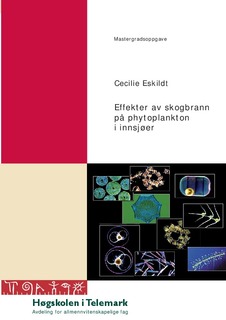| dc.description.abstract | SAMMENDRAG: Som del av forskningsprosjektet Pyrowater undersøkes i denne oppgaven phytoplanktonsamfunn i den hensikt å avdekke eventuelle effekter av skogbrann på organismegruppen. Det har vært få store skogbranner i Norges nyere historie og Froland-brannen 2008 som omfattet 26 000 dekar skriver seg inn som den hittil største. Det berørte området inneholdt hele nedbørsfelt til mange små innsjøer, og brannen har dermed gitt et godt grunnlag for forskning omkring effekter på akvatiske økosystemer. Etter en skogbrann kan det forventes større erosjonsrater i forbindelse med nedbør eller snøsmelting, som igjen kan føre med seg stor tilførsel av sedimentert og økt utlekking av kjemiske komponenter til innsjøer i berørte nedbørsfelt. Phytoplankton, som danner en stor del av grunnlaget til den akvatiske næringsskjeden, vil med sin korte livssyklus ha høy følsomhet overfor miljømessige forandringer. Dette kan gjenspeiles i volum og samfunnsstruktur. Det har blitt studert phytoplanktonsamfunn i ni innsjøer lokalisert i Froland kommune. Seks av vannene har beliggenhet i brente nedbørsfelt, mens tre av vannene har fungert som referanser til de aktuelle miljøforholdene før brann og har beliggenhet utenfor brente områder. Undersøkelsen av phytoplanktoninnholdet har omfattet kvalitative håvtrekk fra 2011, i tillegg til kvalitativ og kvantitativ analysering av phytoplanktonprøver (Utermöhl-metoden) fra de tre påfølgende årene etter brannen (2009-2011). I både håvtrekk og phytoplanktonprøver har det blitt lagt vekt på tilstedeværelse av indikatorarter i forhold til humøsitet, pH og trofigrad. Det ble registrert relativt mange arter hvis indikatorverdi samsvarte med de aktuelle innsjøenes miljøtilstand. Hos phytoplanktonprøvene ble i tillegg det kvantitative aspektet trukket inn ved å se på hvilke volum de forskjellige observerte phytoplanktonklassene utgjorde i hver av prøvene. Gullalgene viste en tydelig dominanse i de fleste av prøvene, men det ble også analysert prøver der svelgflagellater, blågrønne bakterier, panserflagellater, grønnalger og/eller nålflagellater dominerte. Mengden phytoplankton kan ofte relateres til vannets innhold av næringsstoffer og de største volumene ble i mange av innsjøene registrert i 2010, samme året som de fleste av innsjøene også hadde størst utlekking av næringsstoffer. Principal Component Analysis (PCA) ble utført på fysiske og kjemiske miljøvariabler, tilgjengelig i Høgskolen i Telemarks databaser. Detrended Correspondence Analysis (DCA) ble brukt på de biologiske artsdataene for å undersøke forandringer over tid. PCA viste en tydelig utlekking av sulfat (SO4 2- ) og en økning i konduktivitet i berørte innsjøer etter brannen, med avtagende effekt de påfølgende årene.I DCA-ordinasjonen ble det observert en stigende variasjon i artsinventar mellom innsjøene fra 2009 til 2011. Referansevannene inneholdt stort sett de artene som forekom oftest, mens en del av de brannpåvirkede innsjøene hadde mer særegne phytoplanktonsamfunn. En Monte Carlo permutation-test viste at variasjonen i phyoplanktonsamfunnet i de undersøkte innsjøene ikke kunne forklares av tilgjengelige miljøvariabler. ABSTRACT: As part of the research project Pyrowater, the purpose of this master thesis was to find prospective effects of wildfire on the phytoplankton communities in freshwater lakes. There have been few large wildfires in the recent history of Norway. The fire in Froland 2008 is to this date the most massive and has consumed 26 km2. The burned area contained whole catchment areas of many small freshwater lakes, and the wildfire can therefore be used as a good foundation for research on the effects on aquatic ecosystems. After a wildfire there can be expected larger erosion events in periods of heavy rainfall or snowmelting. This can lead to increased input of sediment and chemical components to lakes in impacted watersheds. Phytoplankton, wich serve as the base of the aqutic food chain, has a short cycle of life and species composition respond quikly to environmental changes in the water. Phytoplankton communities in nine freshwater lakes located in Froland commune has been studied. Six lakes were located in burned watersheds while three lakes were located outside the burned area and acted as references to pre-fire conditions. The study of the phytoplankton communities included qualitative phytoplankton net samples from 2011, in addition to qualitative and quantitative analyses of phytoplankton water samples (the Utermöhl-method) from 2009 to 2011. In both net samples and water samples the presence of indicator species in relation to pH, content of humus and trophic state of water was pointed out. Many of the observed indicator species related to the environmental state of the lakes they were found in. In the phytoplankton water samples the quantitative volumes of phytoplankton groups was analysed, in addition to qualitative taxa identification. Chrysophyceae dominated most of the phytoplankton water samples, but samples samples with large proportions of Cryptophyceae, Cyanophyceae, Dinophyceae, Chlorophyceae and/or Raphidophyceae were also analysed. The amount of phytoplankton can often be related to the content of nutrients in the water. The largest volumes of phytoplankton was discovered in 2010 in many of the analysed samples, the same year wich also showed the greatest nutrient input for a lot of the lakes in this study. Physical and chemical variables, available in the Telemark University Colleges databases, were examined in a principal component analysis (PCA). A detrended correspondence analysis (DCA) was used for examining the biological species data for any changes in phytoplankton community structure over time. The PCA revealed distinct sulfate loadings and an increase in conductivity in fire impacted lakes in 2009. The effect was decreasing in 2010 and 2011. When examining all lakes in an DCA ordination there was observed an increasing variation in the species composition from 2009 to 2011.The lakes used for reference contained mostly common species, while some fire impacted lakes had communities wich contained species that occured less often. A Monte Carlo permutation test showed that the variation in the phytoplankton community could not be explained by the available environment variables in the examined lakes. | |
